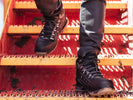
What is the Difference Between Safety Toe and Steel Toe?
, by Ed Stone, 5 min reading time

, by Ed Stone, 5 min reading time
When people think of safety toe footwear, the first image that comes to mind is the classic steel toe work boot. That’s not a bad place to start, as many traditional work boots include a steel toe as a baseline safety standard. But safety toe technology has experienced incredible innovations as seen in newer models of protective footwear.
It isn’t limited to heavy-duty steel toes anymore. Nor are safety toes only found in boots.
You might be wondering: does safety toe mean steel toe? In many ways, they’re interchangeable. But nowadays, the kinds of safety toes available vary widely. And you can find them in a wider range of protective footwear than ever before.
Let’s discuss.
Steel toes are the original, classic design of work safety boots.
Steel toe boots and shoes include an internal toe box made of heavy-duty steel. It covers the phalange bones of your foot, more commonly known as your toes, protecting them from harm.
From the outside, a piece of steel toe footwear may look the same as any other shoe. However, what matters is the steel cap on the inside.
A steel toe box offers the maximum amount of protection from:
All of these hazards may result from heavy objects falling on your foot, a hazard shared by a wide variety of occupations. All construction and building-adjacent fields involve working with or near heavy materials that could drop at any second. That’s why most women’s and men’s construction boots are typically made of the sturdiest materials.
An injury to the toes and feet can be debilitating, throwing off your balance and leading to other injuries, as well. That’s why OSHA requires ASTM-rated protection on safety footwear used for work. With a steel toe cap, you know that your feet—and you—are protected. So, does this mean that steel toe shoes are the be all and end all? And if not, what type of footwear protects your entire foot besides the standard steel toe?
Queue the safety toe.
What is a safety toe boot? What is a safety toe? It’s almost the same thing as a steel toe. In fact, all steel toes belong in the category of safety toes.
But not all safety toes are steel.
All safety toes work in the exact same way as steel toes, explained above: a layer of tough, durable material is inserted into the toe box of the boot or shoe. That toe box might look special from the outside, or you might not even know it’s there.
The difference is that the material underneath isn’t always steel.
Safety toes are often made from:
The above materials offer benefits comparable to steel toe protection. Like their steel counterparts, they’re ASTM-certified to protect you from workplace hazards. And, aside from an alloy toe, these options are all non-metal, which makes them ideal for certain job sites.
So, is safety toe steel toe, categorically? No. But it does meet many of the same safety specifications and standards. Whichever one you use should protect you.
That brings up the question:
In a way, yes.
In practice, safety toes offer many of the same benefits as steel toes, so they may be considered interchangeable. But there are some important differences between them.
For one thing, steel and safety toes are found in different kinds of shoes. Some boot and shoe models are better suited to non-steel toe boxes. Since some safety toes are made of lighter materials, they can work better in hybrid shoes like work sneakers, as opposed to a safety boot. Although a safety boot may be more heavy-duty, there are still many features that brands have added to footwear to produce comfortable steel toe boots that will keep you safe without hurting your feet.
No matter what kind of shoe, there are some trade-offs between steel cap and safety toe cap shoes. And there are scenarios where one might be preferable to the other. For instance, consider:
Whether you need women's and men's steel toe boots or safety toe shoes, or any other kind of footwear, Boot World has an option that’ll fit your needs. We carry your favorite brands including women’s and men’s Timberland PRO boots, CAT boots, and more. Reach out today or browse our inventory to find the safety toe shoe you’ve been looking for.